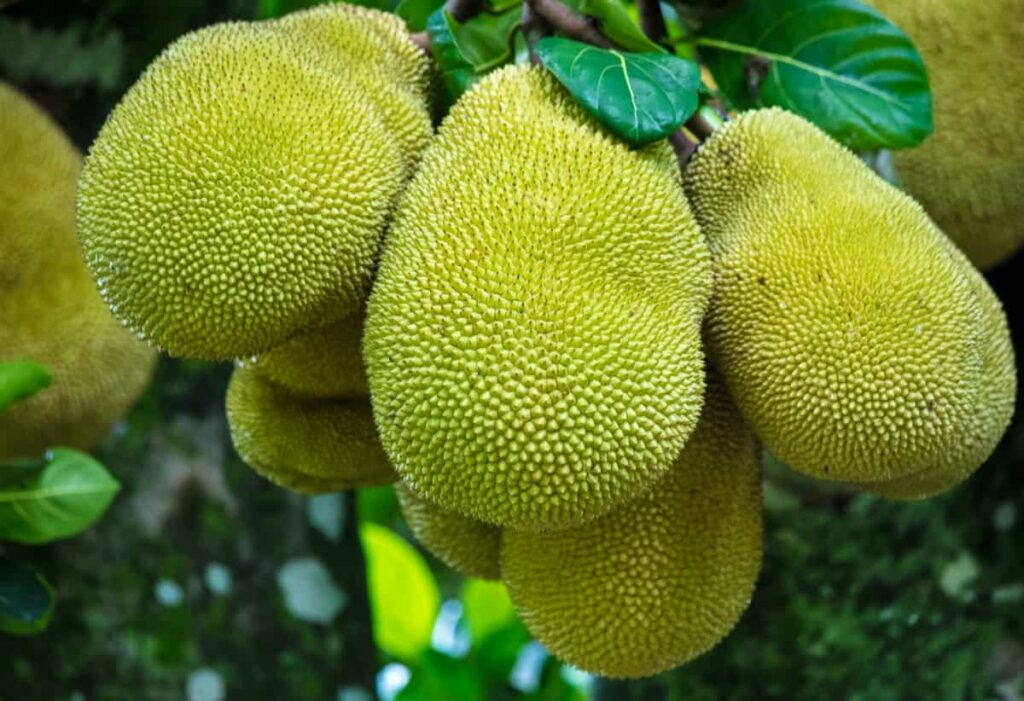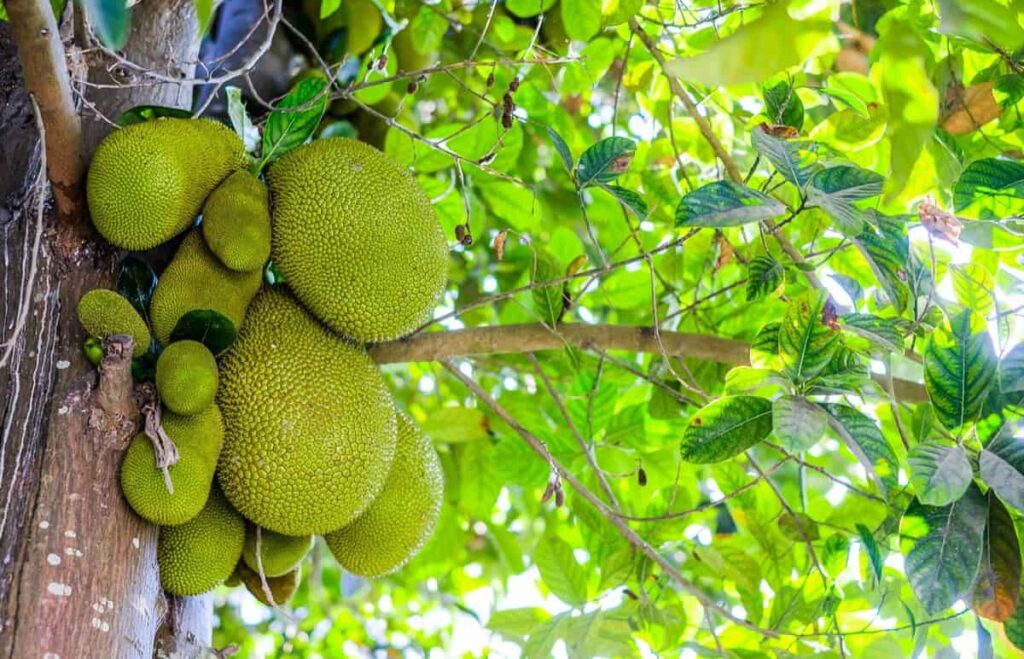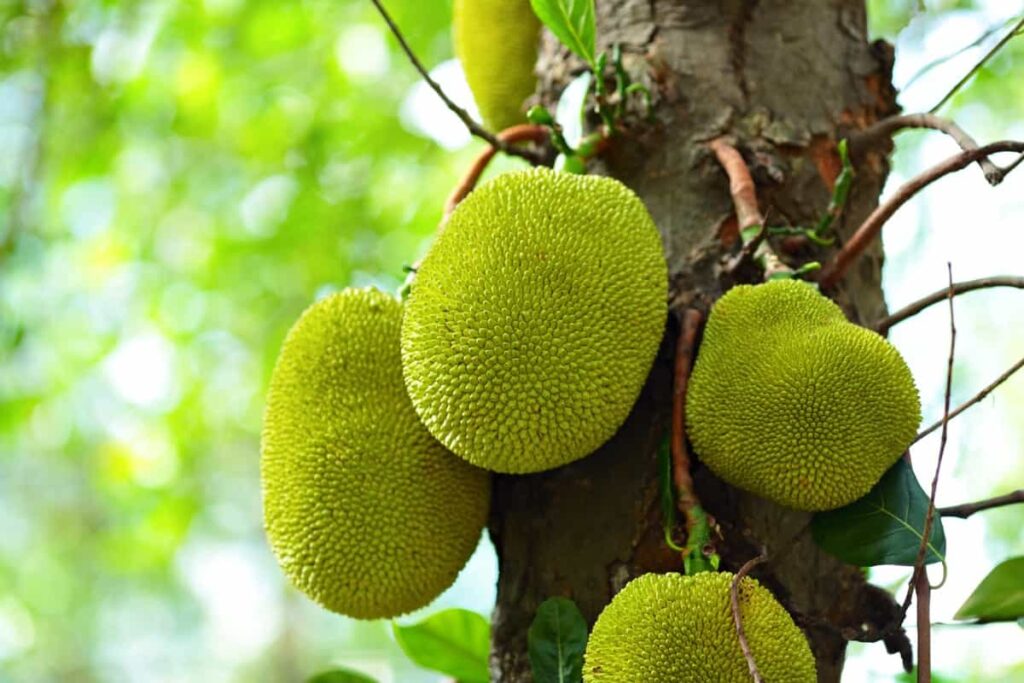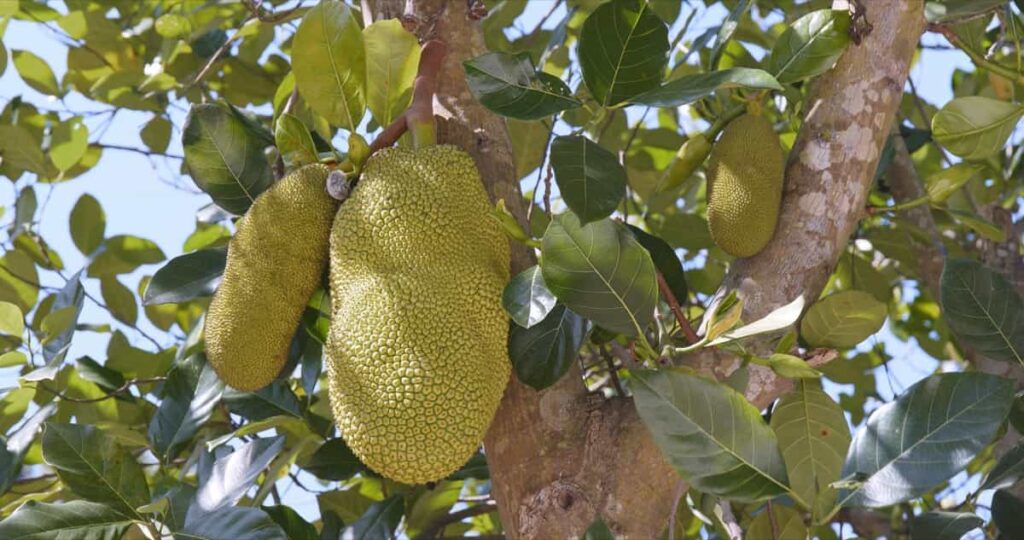Welcome, to jackfruit cultivation in the Philippines – a tropical paradise renowned for its diverse varieties, propagation techniques, and essential care tips. In this blog, we’ll embark on a delightful journey through the fascinating realm of jackfruit farming, simplifying complex data with precision.

Discover the plethora of jackfruit variants available, from the sweet Honey Gold to the aromatic Black Gold. Learn about propagation methods, such as seedling and grafting, to ensure successful cultivation. Unearth the secrets of nurturing these majestic trees, from optimal soil conditions to proper watering and pruning.
Introduction to Growing Jackfruit in the Philipines
Jackfruit cultivation in the Philippines is thriving due to its tropical climate and significant role in the country’s economy. With abundant rainfall and temperatures ranging from 20°C to 35°C, jackfruit trees thrive in various regions. The country has become a major exporter of jackfruit, catering to global demand for its unique taste and texture.
Jackfruit production in the Philippines has increased by 20% in the last five years, attributed to government support for agricultural development and modern farming practices. The ease of propagation and low maintenance requirements make jackfruit cultivation accessible to small-scale farmers and large plantations.
Popular Varieties of Jackfruit in the Philippines
- Artocarpus heterophyllus (Var. “Honey Gold”): Known for its exquisite sweetness and aromatic flavor, this variety delights taste buds nationwide. It boasts a golden-yellow hue and tender, succulent flesh.
- Artocarpus heterophyllus (Var. “Black Gold”): This variety stands out With a striking dark green skin and exceptionally sweet taste. Its flesh is deep yellow and emits a delightful fragrance.
- Artocarpus heterophyllus (Var. “Golden Nugget”): True to its name, this variety gleams like a nugget with a delectable taste that wins hearts.
- Artocarpus heterophyllus (Var. “Dang Rasimi”): Celebrated for its larger fruit size and rich flavor, it has become a favorite in various tropical regions.
- Artocarpus heterophyllus (Var. “Malbhog”): Renowned for its uniquely shaped, elongated fruit and distinctive sweetness.
In case you missed it: Optimizing Jackfruit Orchard Management: A Month-by-Month Operation Guide for Maximum Yield

Growing Jackfruit in the Philippines
Growing jackfruit in the Philippines is common, as it ranks sixth among the country’s major fruit crops. Despite its significance, there is a lack of widely adopted technologies for asexual propagation, orchard establishment, nutrition, fertilization, and pest management. This hinders the full exploitation of jackfruit’s potential. The Philippines offers five recommended outstanding jackfruit varieties, but the need for proper orchard management practices poses a challenge for growers.
To unlock the full potential of jackfruit, efficient processing technologies are essential. This includes aggressive promotion of both fresh and processed products. The jackfruit industry can thrive by developing a wide array of processed products with widespread acceptance in local and international markets. Major industry players face two critical challenges. First, they must establish jackfruit as a major orchard crop, enhancing its status and importance in agricultural practices.
Second, they must focus on developing diverse processed products that appeal to consumers globally. Addressing these challenges requires collaboration between farmers, researchers, and policymakers. Proper dissemination of modern techniques for asexual propagation, orchard management, and pest control will improve yields and quality. By promoting jackfruit products through strategic marketing efforts, both locally and internationally, the demand can rise significantly.
The potential of jackfruit in the Philippines is vast, and with proper support and utilization of advanced technologies, it can become a thriving and economically valuable crop. Cultivation and marketing of this versatile fruit are promising to enhance farmers’ livelihoods and contribute to the country’s overall agricultural growth.
Propagation Methods for Jackfruit Trees
Growing Jackfruit from Seeds
- Collect ripe jackfruit seeds from healthy fruit.
- Soak the seeds in water for a day to enhance germination.
- Plant the seeds in well-draining soil, about 1 inch deep.
- Ensure the planting location receives ample sunlight.
- Regularly water the seeds, keeping the soil consistently moist.
- Germination typically takes 2 to 3 weeks.
- Transplant the seedlings to larger pots once they have leaves.
- Gradually change the seedlings to outdoor conditions before planting in the soil.
- Seed-grown jackfruit trees may take 4 to 5 years to bear fruit but develop a strong root system.
In case you missed it: How to Encourage Female Fruit Flowers: Increasing Tips and Techniques

Grafting Techniques for Jackfruit Propagation
- Select a healthy rootstock tree with desirable traits like disease resistance or vigorous growth.
- Choose a scion, a young shoot from a high-quality jackfruit tree with preferred fruit characteristics.
- Make a diagonal cut on the rootstock and scion, ensuring they match the size.
- Join the two pieces, securing them with grafting tape or rubber bands.
- Apply grafting wax to protect the graft union and prevent infections.
- Keep the grafted Tree in a warm, humid environment to facilitate healing.
- Once the graft has successfully united, transplant the Tree to a suitable location.
- Grafted jackfruit trees bear fruit in 2 to 4 years and maintain the characteristics of the scion.
Air Layering as a Propagation Method for Jackfruit Trees
- Select a healthy, low-hanging branch from a mature jackfruit tree.
- Make a 1-inch long, shallow cut in the middle of the selected branch.
- Dust the cut with rooting hormone to encourage root development.
- Wrap the wounded area with moist sphagnum moss, securing it with plastic wrap or foil.
- Monitor the moss regularly and keep it consistently moist.
- After 4 to 8 weeks, roots should develop in the moss-covered area.
- Sever the rooted section from the mother tree and plant it in a suitable container.
- Nurture the air-layered plant until it establishes itself well in the soil.
- Air layering allows for faster fruiting, as the new Tree retains the traits of the parent plant.
Selecting the Right Location for Jackfruit Plantation
To ensure successful jackfruit plantation growth, choose well-draining, deep soil with a pH level of 5.5 to 7.0, rich organic matter, sandy loam or clay loam, avoid saline or alkaline soil, choose a gentle slope, ensure full sunlight, and consider windbreaks to protect young trees from strong winds. Choose a location with a gentle slope to prevent waterlogging during heavy rains and ensure the site receives full sunlight for optimal growth and fruit production.
Soil Requirements for Jackfruit Cultivation
Jackfruit cultivation requires well-draining soil, a pH range of 6.0 to 7.5, sandy loam or loamy soil, organic matter, balanced fertilizers, mulch, proper drainage, and regular soil testing. In the Philippines, it’s recommended to space jackfruit trees at least 8 to 10 meters apart to allow sufficient room for their expansive canopy and root system. These factors ensure optimal nutrient absorption, aeration, water retention, and robust growth. Fertilization, mulching, drainage, and testing are essential for maintaining healthy root development and preventing water stagnation.
Climate and Temperature Considerations for Growing Jackfruit in the Philippines
Jackfruit cultivation in the Philippines requires careful consideration of climate and temperature conditions. It thrives in a humid tropical to near-tropical climate, requiring a warm and humid environment. Jackfruit trees prefer temperatures between 25°C to 35°C, with short periods of higher temperatures allowing growth. Adequate rainfall is crucial, with 1500mm to 2500mm annual rainfall.
In case you missed it: Optimizing Mango Orchard Operations: A Comprehensive Guide for Month-wise Planning

Full, direct sunlight is essential for jackfruit growth, and plants should be placed in locations with ample sunlight exposure. Proper irrigation is essential during dry spells. Sandy or loamy soils with slightly higher pH are ideal for jackfruit cultivation, with rich, deep, and somewhat porous soil. Jackfruit trees thrive at low to medium altitudes, typically below 700 meters above sea level.
Watering and Irrigation Practices for Jackfruit Trees
Jackfruit trees require proper watering and irrigation to maintain soil moisture and prevent stress. Young trees need more frequent watering, while mature trees can be watered every 7-10 days. Deep watering ensures roots penetrate deeper into the soil. Rainwater harvesting systems supplement irrigation needs naturally. Drip irrigation delivers water directly to the root zone, reducing wastage. Organic mulch helps retain moisture and inhibits weed growth. Regular monitoring helps prevent overwatering or drought stress.
Fertilization and Nutrient Management in Jackfruit Plantations
Fertilization and nutrient management play a role in successfully cultivating jackfruit plantations. To promote growth, it is recommended to use balanced fertilizers with a nutrient ratio of 16-20-0 (75%) and ammonium sulfate (25%) every three months. Incorporating organic fertilizers into the soil can enhance fertility and provide essential nutrients. During the initial stages, it is advised to mix compost with topsoil and add 20 tablespoons of match fertilizer in the root zone to support root development.
Pruning and Training Techniques for Jackfruit Trees
Pruning and training are crucial for healthy jackfruit trees. At around two years old, prune by cutting the main stem’s top, leaving 2-3 meters above the ground to control height. Apply fungicide to the wounds. Remove unproductive, diseased, and insect-damaged branches, as fruits grow mainly on the trunk and large branches. By doing so, the developing fruits receive more light.
In Thailand, a systematic pruning approach is adopted. Prune the main trunk well above the bud union to stimulate multiple branches near the ground. Allow four or more main branches to carry the fruits, preventing heavy fruit distribution on the main trunk. This method also promotes better light penetration and air circulation by opening the center of the Tree.
Pest and Disease Management in Jackfruit Cultivation
- Fruit fly infestation: The destructive fruit fly lays eggs under the fruit’s skin, leading to larvae that cause rot. To control, wrap fruits with cement bags or jute sacks and spray with pesticide.
- Twig borer: These borers attack twigs, causing them to dry up. Cut off affected shoots and twigs and burn them. Spray the Tree with recommended insecticides twice a month.
- Bark borer: Remove dead branches where the pest lays its eggs. Spray recommended pesticides and burn affected twigs and branches.
- Fungal pink disease: Common during the rainy season, it affects jackfruit. Spray plants with sulfur fungicide twice a month during this period and prune and burn severely affected branches.
In case you missed it: Peach Orchard Management: A Comprehensive Maintenance Guide for Month-wise Planning

Economic Viability and Profitability of Jackfruit Farming in the Philippines
Jackfruit farming in the Philippines offers unique challenges and opportunities. The latex-less jackfruit, a special variety, stands out with its sweet and resin-free fruit, making it an ideal choice for a delicious dessert. However, other jackfruit varieties may be resinous and take longer to bear fruit, discouraging some farmers from planting. Experts recommend grafting a scion from a desirable jackfruit tree onto a seedling to propagate high-quality seeds. This ensures that the new Tree inherits the desired traits.
Jackfruit can also be propagated through air layering, producing a new plant with the same characteristics as the parent tree. When planting jackfruit, selecting a sunny location with well-draining soil is essential. Adding organic matter and applying appropriate fertilizers at regular intervals promote healthy growth. Jackfruit farming is highly profitable, with potential revenues ranging from P280,000 to P720,000 per season per hectare, depending on the yield and market prices.
The main jackfruit-producing regions in the Philippines are the Bicol Region, especially Albay, and Batangas, particularly in Malvar. Jackfruit trees can bear fruit in 3 to 4 years, and the fruit is ripe and ready for harvest from March to May. These trees are sensitive to frost and require a humid tropical or near-tropical climate. The lifespan of a jackfruit tree can extend from 30 to 60 years, with the Tree itself living up to a century.
Harvesting and Post-harvest Handling of Jackfruits
Harvesting jackfruit requires careful consideration of ripeness indicators, such as yellowing leaves, hollow sounds when tapped, and well-spaced spines yielding to pressure. Pick soft, aromatic fruit with a yellow leaf near the stalk for home consumption. For sale, harvest mature, firm fruit without aroma. Carefully cut the peduncle with gloves to avoid spines, and use sacks when harvesting from tall trees.
To reduce latex flow during harvesting, from mid-morning to late afternoon. After picking, remove unwanted water sprouts from the trunk. When handling fruit, let the latex flow and coagulate by laying the fruit against a railing with the stalk down. Transport fruits in single layers, using dried banana leaves to prevent bruises and breaks. Avoid inserting sticks into the stem, as it promotes decay.
Post-harvest, remove immature or damaged fruits and grade the remaining ones according to size. Wash fruits with chlorinated water, drain them, and pack them in plastic containers or bamboo baskets for storage. Ripe fruits can be stored at specific temperatures and humidity levels, depending on the cultivar and maturity stage.
For pre-processing, fully ripen jackfruits at 24-27ºC or use ethylene gas for uniform ripening. To turn them into fruitlets, cut, deseed, and sort accordingly. Fruitless can be packed in polythene bags or containers and kept at 2ºC for three weeks. Pulp preparation involves crushing deseeded bulbs, adding sugar, drying, and storing at -20 – -22ºC.
In case you missed it: Zone 6 Gardening Guide for Vegetables, Fruits, Herbs, Flowers, and Month-to-Month Calendar

Jackfruit Yield per Tree
Jackfruit yield per Tree can vary based on age, health, and growing conditions. An average mature jackfruit tree can produce 60 to 200 fruits annually, weighing 5 to 15 kilograms each. Optimal care and proper management can enhance yield and fruit quality. Jackfruit trees take about 3 to 4 years to bear fruit and can continue producing for 30 to 60 years. On average, a well-managed jackfruit plantation can accommodate 70 to 180 trees per acre, with a potential annual yield of 4.9 to 18 tons per hectare, depending on the planting density and fruit size.
Conclusion
Growing jackfruit in the Philippines offers a rewarding experience with diverse varieties, successful propagation methods like grafting and air layering, and proper care practices. By embracing these techniques, farmers can enjoy a bountiful harvest of this tropical delicacy.
- How to Raise Pigs in Your Own Backyard: A Comprehensive Guide
- Budget Friendly Sheep Shed Ideas: Cheap and Low-Cost Tips
- How Much Do Cattle Farmers Make: Revenue Streams in Cattle Farming
- Management Pests and Diseases in Your Cotton Field
- Sheep Farming Business Plan for Beginners
- Aquaponic Farming at Home: A Step-By-Step Guide
- Profitable Village Farming Business Ideas in 2024
- High-Yield Aquaculture: Fast-Growing Fish for Farming
- Effective Fish Pond Construction Techniques for Beginners
- Irrigation and Water Management in Pineapple Farming
- Blossom to Harvest: Mastering Flowering and Pollination in Papaya Farming
- Pig Fattening Essentials: From Selection to Sale for Beginners
- Raising Wagyu Cattle: A Complete Guide for Premium Beef Production
- Soil Types and Their Water Holding Capacity
- Optimizing Irrigation Schedules for Coconut Groves for Enhanced Yield
- Espresso Your Garden: Coffee Grounds for Healthier Acid-Loving Plants
- The Best Soil Mix for Snake Plants: How to Mix Your Own Snake Plant Soil
- Green Thumb Success: Expert Tips for Cultivating Greenhouse Beans All Year Round
- Bloom All Year Round: The Ultimate Guide to Indoor Hyacinth Care
- Eco-Friendly Gardening: How to Make Liquid Fertilizer from Kitchen Waste
- Ultimate Guide to Grow Anise in Pots: Explore Seed Propagation to Harvesting
- Guide to Raising Chester White Pigs: Discover Breed Facts to Growth Management
- Mastering the Elegance: The Ultimate Guide to Weeping Cherry Tree Care, Planting, and Maintenance
- Ultimate Guide to Planting Garlic in Grow Bags: Growing Strategies for Beginners
- How to Fix Spider Plant Leaf-Related Problems: Natural and Organic Remedies
- 10 Reasons Why Your Tulsi Plant is Shedding Leaves: Home Remedies and Solutions
- Optimizing Growth and Yield: The Advantages of Palm Bunch Ash Fertilizer
- Utilizing Neem Oil Extract as a Natural Pesticide for Hydrangea
- From Soil to Harvest: Various Ways in Which Farmers Can Use AI Tools
- Steps to Encourage and Induce Citrus Flowers: A Comprehensive Guide
- How to Fix Snake Plant Leaf-Related Issues: Natural and Organic Remedies
- Transform Your Garden into a Fragrant Oasis with Raat Ki Rani (Night Blooming Jasmine)
- Discover the Ideal Chicken Breeds for Philippine Farms
- How to Create a Poultry Egg Farm Business Plan for Profits
- Grow Lemon Cucumbers Like a Pro: Insider Techniques for Bountiful Yields
- Ultimate Guide to Caring for Your Pink Princess Philodendron: Tips for Thriving Variegation
